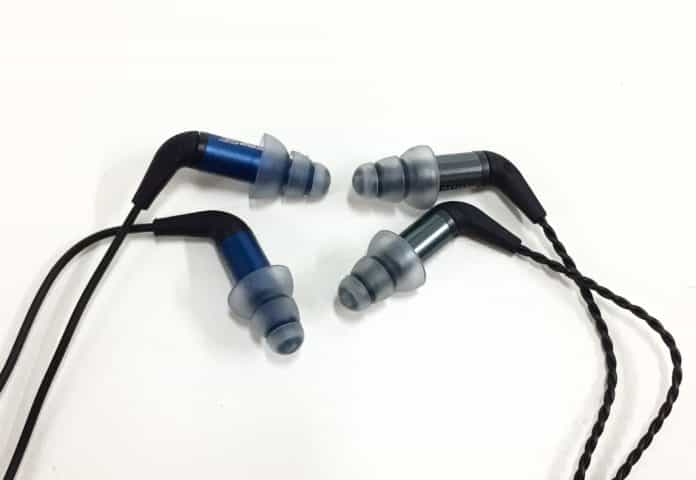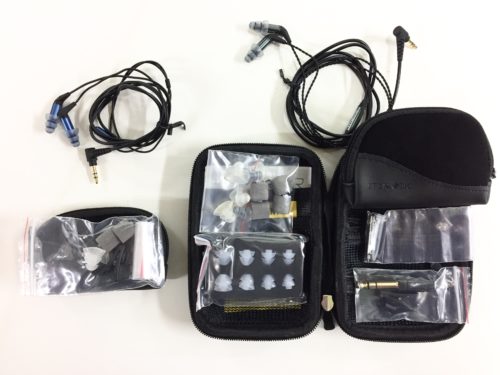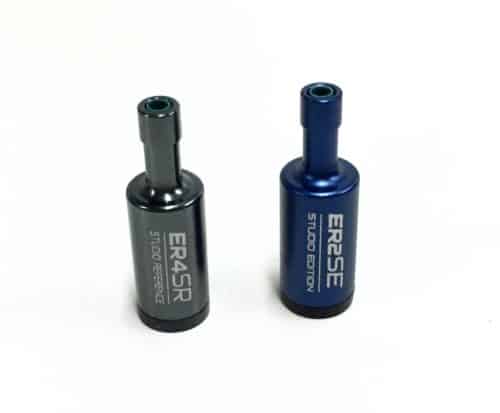When the Etymotic ER4 was originally released, way back in the 90s, it was one of the first IEMs in existence. Sporting a utilitarian “deep insertion” design and a single balanced-armature driver, it may seem less technically advanced than today’s fancy multi-BA or hybrid IEMs. But make no mistake: the $300 Etymotic ER4SR, the latest update of the ER4 along with the ER4XR, is still one of the best-sounding IEMs on the market, especially in the under-$500 (or even under-$1,000) price bracket.
Rather than following the market and releasing even higher-priced models, Etymotic has recently been pushing the bottom line even lower, releasing impressively-performing models at the below-$200 range. Last year, they released the ER2SE and ER2XR, two IEMs that are both priced at around $160.
I’ve been very impressed with the ER2SE – in fact, I own a pair myself, and you can read my review of them here. The risk for Etymotic is that the ER2SE will prove as good as the ER4SR or even better, rendering the ER4SR obsolete. And that’s what I’m attempting to discover today – how exactly does the ER4SR improve over the ER2SE, and is it worth the extra ~$150?
In the Box
Probably the single biggest problem I had with the ER2SE was a lack in the variety of included eartips. On one hand, that says something pretty significant about the ER2SE’s sound quality; on the other, it means that some people will be stuck looking for replacement eartips.
With the ER4SR, this is not a problem. While the ER2SE comes with one extra pair of triple-flange eartips and one extra pair of foams, the ER4SR comes with three additional triple-flange, two additional foams, and a bunch of double-flange, all of varying sizes. There are also a few more additional goodies with the ER4SR, including a larger carrying case and a 1/4-inch adapter. All is listed below:
| ER4SR | ER2SE |
|---|---|
| 4x triple-flange eartips | 2x triple-flange eartips |
| 2x foam eartips | 1x foam eartip |
| 4x double-flange eartips | – |
| Filter replacement tool and two replacement filters | Filter replacement tool and two replacement filters |
| Small soft carrying bag and large hard carrying case | Small soft carrying bag only |
| 1/4-inch adapter | – |
| Shirt clip | Shirt clip |
Build quality and Appearance
The Etymotic ER2SE and ER4SR are essentially built identically, with only a few small differences. Both, I would say, are exceptionally well-built. Both feature precision-machined metal bodies. And both feature a proprietary MMCX connector (with a small notch build in to prevent the IEMs from rotating around the cable).
Appearance-wise, they are only very slightly different. While the ER2 has a matte blue finish, the ER4 is a glossy dark grey.
The included cables are slightly different as well, although neither is particularly good. The ER4SR’s cable is braided above the Y-splitter, and is a bit more flexible than the ER2SE’s non-braided cable. In addition, the ER4SR’s cable below the Y-splitter is a bit thicker and thus probably a bit sturdier.
Both cables have some issues with being microphonic – i.e., transmitting the sound of rubbing against your clothes or bumping against household objects. This can be mostly mitigated by wrapping the cables over your ears while wearing. This is slightly easier with the ER4SR cable, due to its increased flexibility, but realistically it won’t be an issue with either.
Comfort
The Etymotic ER2SE and ER4SR are intended to sit deep in the ear – much deeper than other IEMs. This grosses some people out, and for some (including me) it’s slightly uncomfortable at first. In my experience, this discomfort goes away over time – it’s something you just learn to get used to, and should only take a couple days.
Neither IEM will vary in this respect. I will say, though, that this comparison review was kind of unpleasant to do as a result. Once the Etymotics are in my ears, they’re fine, but repeatedly removing and re-inserting them got to be kind of a drag.
Of course, both isolate sound very well – you won’t hear anything while you’re wearing them, which is why I tend to use them for my daily commute.
Sound
For more details on how I describe sound, check my article “How Headphones Sound (to me).”
Etymotic’s IEMs typically sound dead-neutral. The company is known for their strict adherence to an in-house target that mostly replicates the Diffuse-Field Target. So both the Etymotic ER2SE and ER4SR are tuned to the same target, and thus they sound very similar, when compared to other products.
One might be tempted to think they sound almost exactly the same based on the frequency response graphs alone. Yet they do sound different, though it’s slightly difficult to describe exactly how.
The source of the basic difference in the sound is the driver itself. While the ER4SR uses a single balanced armature (BA) driver, as all past ER4 variants have, the ER2SE uses a dynamic driver. This results in a tone that is weightier, but also less refined.
Based on the sound, I’d probably be tempted to call it for the ER2SE as the better deal overall. The ER4SR is very competitive at its price, and for $350, I can’t think of a much better pair of IEMs. If anything, the ER2SE is simply underpriced – it could probably command significantly more than its $160 going price.
Regardless, the ER4SR and the ER2SE offer different things, so let’s get further into what those things are.
Bass
Neither the ER2SE nor the ER4SR are bass-heavy IEMs by any standards. Both offer “studio responses,” meaning dead neutrality with maybe a slight bass roll-off to prevent bass from getting obtrusive (but not much of one). Despite their similar, even identical, frequency responses in the bass, though, the two offer significantly different experiences.
The ER2SE’s bass is, by and large, better. You’d expect that from a dynamic driver. Balanced-armature drivers are known for having slightly “hollow-sounding” or “airy” bass. I don’t find that to be wholly true of the ER4SR, but the ER2SE definitely strikes me as more impactful and tighter in the bass, by a small amount. The bass on the ER4SR, on the other hand, is perhaps “airier” or more “textured.”
Truth be told, though, the difference in bass response is more slight than most people would say. Neither is going to be at all appropriate for bassheads – generally speaking, I’d say true bassheads should probably steer clear of Etymotic. However, if you’re looking for a similar sound with more bass, both the ER2 and ER4 have XR variants, which have a greater emphasis on the bass without becoming overly bassy.
Mids
Compared to the ER2SE, the ER4SR seems a bit less mid-forward and a bit more balanced. There seems to be a bit more treble energy with the ER4SR. The midrange also seems to be a bit thinner and more “precise-sounding” on the ER4SR. Again, we can’t account for either of these differences by looking at the frequency response alone. We also have to consider the way each driver behaves.
One thing is for certain. The ER4SR is definitely more resolving than the ER2SE, and this includes the midrange: the low-level details are more accessible to the listener on the ER4SR. The ER2SE is no slouch in this department, though, beating pretty much every other IEM at its price range, but it loses out just a bit to the ER2SE.
However, the ER2SE does seem to have better dynamics, not only in the midrange but also in the bass. It has more slam and dynamic contrast as well. So the ER2SE offers a less refined sound, but it may offer a slightly more exciting one.
Treble
Both the ER2SE and the ER4SR perform very well in the treble, but here I think the price gulf starts to be even more obvious. The ER4SR offers pinpoint accurate, completely grainless treble. It does have more treble energy than the ER2SE, but it’s not bright, exactly, nor is it much more fatiguing.
I don’t get a sense that the ER2SE is grainy, either. To me, it still offers a pretty natural treble response. But it is missing a little bit of extra refinement – one gets a sense of “solidity” in the treble of the ER2SE, but not quite as much air or space.
Soundstage
The Etymotics have always been somewhat known for having a flat soundstage that doesn’t offer great depth or a sense of space. It’s true that I had trouble on the few occasions I had to use the ER2SE for mixing because I had issues discerning the dimensions of the stage. It’s that way with the ER4SR as well, but the greater resolution allows for more instrument separation and a better sense of space.
Given all the other strengths of the Etymotics, though, I more than forgive them for their soundstage deficiencies – and I say this as someone who typically prioritizes soundstage. They’re really not much weaker than other earphones at their price, and they simply sound so good in every other aspect.
Pros and Cons
ER2SE
Pros: Extremely good value, good dynamics
Cons: Slightly lacking in “air,” not quite as resolving as ER4SR
ER4SR
Pros: Better resolution than ER2SE, airier and better-separated sound, more refined, more accessories, still a good value
Cons: Bass doesn’t hit as hard, dynamics not quite as good or exciting
In Conclusion
Etymotic is a company that’s attracted great brand loyalty for a reason. While some won’t enjoy the dead-neutral, slightly clinical sound signature of the Ety’s (especially the Studio versions), or the slightly weird fit, one can’t deny that both the ER4SR and the ER2SE offer extraordinary sound quality at their respective price points.
While the ER2SE is a great entry into the Etymotic product sphere, the ER4SR takes things that extra step, giving everything a slightly more refined and airier sound. I think those who’ve tried and enjoyed the ER2SE’s sound will likely want to step up to the ER4SR at some point in their lives – the improvement is certainly not negligible.
The Etymotic ER2SE and ER4SR are both available on Audio46’s website: the ER2SE here, and the ER4SR here. They’re also available on Amazon: the ER2SE and ER4SR.
Technical Specs
| Specification | Etymotic ER2SE | Etymotic ER4SR |
|---|---|---|
| Driver configuration | 1 x dynamic driver | 1 x balanced-armature driver |
| Noise isolation | 35-42 dB | 35-42 dB |
| Impedance (@1kHz) | 15 Ohms | 45 Ohms |
| Sensitivity (@1kHz, 0.1v) | 96 dB | 98 dB |
| Maximum output | 120 dB | 122 dB |
As a disclaimer, MajorHifi may receive commissions from retail offers.
Compare the ranking of various headphones, earbuds and in-ear monitors using our tools.
Discuss this, and much more, over on our forum.
---MAJORHIFI may receive commissions from retail offers.



















